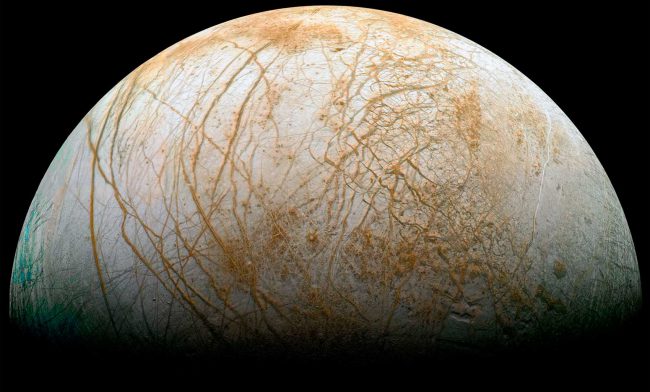Lethal levels of radiation deprive Jupiter’s moon of oxygen
- March 4, 2024
- 0
To remotely assess the habitability of a space object, it is necessary to understand what molecular compounds are present on it and how they interact. Based on data
To remotely assess the habitability of a space object, it is necessary to understand what molecular compounds are present on it and how they interact. Based on data

To remotely assess the habitability of a space object, it is necessary to understand what molecular compounds are present on it and how they interact. Based on data collected by the Juno spacecraft, scientists calculated the movement of the simplest elements on Europa, Jupiter’s moon covered with an ice crust.
Europa is the fourth largest moon of Jupiter and one of the few bodies in the solar system covered by a shell of ice beneath which an ocean of liquid water hides. That’s why it’s so interesting to astronomers. So are there enough beneficial elements in the ocean? Oxygen is scarce there, a new study of the moon’s icy surface shows.
The icy crust of Europe is under the constant and extremely strong influence of cosmic rays. This is due to the neighborhood of Jupiter’s super-strong magnetosphere, which saturates the space near the planet with particles of large numbers of noticeable energy. The daily dose on the European surface is 5.4 Siverts. So in a place like this, most people would die from the effects of radiation after being there for just one day.
Charged particles break molecular bonds in H2O. After recombination, mostly molecular hydrogen H is formed2 and oxygen O2. Theoretically, some of this oxygen enters the subglacial ocean, some remains at the surface, and some flies into the atmosphere.
Based on observations and computer models, scientists have tried to predict the composition of the atmosphere and the amount of oxygen released. It turns out that the emission of “production” alone is very large: from 5 to 1100 kilograms of oxygen per second. The Juno probe, which flew to Jupiter in 2016, was able to directly collect the data required for such an analysis for the first time.
In September 2022, the Juno spacecraft approached Europe at a distance of 353 kilometers. Designed to study Jupiter’s magnetosphere and auroras, the JADE instrument captured and analyzed the amount of ions (charged particles formed by the interaction of cosmic radiation with the atmosphere) in the moon’s atmosphere.
Based on these data, Jamey Szalay from Princeton University (USA) and colleagues from other universities calculated the exact amount of neutral hydrogen H.2Europe’s atmosphere is losing 1.5±0.8 kilograms per second. And neutral hydrogen is a good indicator of the evolution of the satellite’s ice shell.
Assuming all these are H2 According to this phenomenon, which occurs when water molecules in the ice break down, the authors calculated that approximately 12.6 kilograms of molecular oxygen O should be released in the same process.2 And this is at best, because the authors assumed that all atmospheric H2, calculated according to Juno data, is formed in this way. According to some computer models, the ice crust should have released more than a ton of oxygen per second. And it turned out to be no more than 18 kilograms.
Based on modeling results from other studies, the authors of a new paper published in the journal Nature AstronomyHe concluded that molecular oxygen could only form a thin layer on Europa’s surface.
How much goes into the frozen ocean? Estimates from other studies suggest that the range of oxygen “leaking” from the ice crust may range from 0.3 to 300 kilograms of O2.2 Every second the new result is “produced” a maximum of 18 kilograms.2 per second – imposes much stricter limits.
Theoretically, if oxygen “production” had been much higher in the distant past, entire oxygen reserves could have been preserved in the ice crust that “feeds” the subglacial ocean. If this were not the case, suitable conditions for aerobic life would not develop in the oceans. However, it is worth remembering that lack of oxygen is not necessarily a problem for anaerobic bacterial life.
Another interesting result of the new study is that Europa’s ice shell should lose 1.5 ± 0.8 centimeters of thickness every million years. Doesn’t seem like much. It turns out that this is, in fact, the main process that changes the surface of the satellite. It is “more effective” than falling meteors. And this must be taken into account if we hope to still find traces of some life activity in the ice crust.
Source: Port Altele
As an experienced journalist and author, Mary has been reporting on the latest news and trends for over 5 years. With a passion for uncovering the stories behind the headlines, Mary has earned a reputation as a trusted voice in the world of journalism. Her writing style is insightful, engaging and thought-provoking, as she takes a deep dive into the most pressing issues of our time.